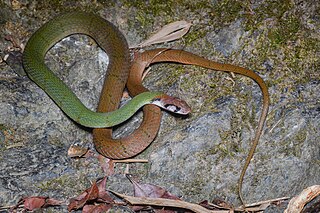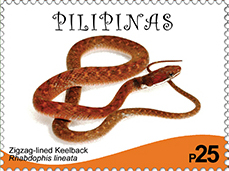
Rhabdophis subminiatus, commonly called the red-necked keelback or red-necked keelback snake, is a species of venomous snake in the subfamily Natricinae of the family Colubridae. The species is endemic to Asia.

The Natricinae are a subfamily of colubroid snakes, sometimes referred to as a family (Natricidae). The subfamily comprises 36 genera. Members include many very common snake species, such as the European grass snakes, and the North American water snakes and garter snakes. Some Old World members of the subfamily are known as keelbacks, because their dorsal scales exhibit strong keeling.

Rhabdophis is a genus of snakes in the subfamily Natricinae of the family Colubridae. Species in the genus Rhabdophis are generally called keelback snakes, and are found primarily in Southeast Asia.

The specklebelly keelback is a species of colubrid snake found in southeast Asia.

Rhabdophis nigrocinctus, also known as the black-striped keelback, green keelback, or banded keelback, is a keelback snake in the family Colubridae found in Myanmar, Thailand, Laos, Cambodia, Vietnam, and Yunnan.

Rhabdophis rhodomelas, the blueneck keelback or blue-necked keelback, is a species of snake in the subfamily Natricinae of the family Colubridae. It is found in the Malay Peninsula, Borneo, and in the western parts of the Indonesian Archipelago.

Rhabdophis chrysargoides, commonly known as the Javanese keelback or Günther's keelback, is a keelback snake in the family Colubridae found in Java, Indonesia.

Tropidonophis spilogaster, commonly known as the northern water snake or Boie's keelback, is a keelback snake in the family Colubridae found in the Philippines on the islands of Catanduanes, Polillo, Calayan and in the province of Bataan on the island of Luzon. The snake’s venom toxicity is unknown due to lack of study.

Rhabdophis nuchalis, commonly known as the Hubei keelback, is a venomous keelback snake in the family Colubridae found in northeast India, Myanmar, China, and Vietnam.
Rhabdophis adleri is a species of keelback snake in the family Colubridae. The species is endemic to China.
Rhabdophis akraios, the Singalang keelback, is a keelback snake in the family Colubridae. It is endemic to Sumatra, Indonesia.
Rhabdophis angeli, also known commonly as Angel's keelback, is a species of keelback snake in the family Colubridae. The species is endemic to Vietnam.
Rhabdophis barbouri, also known commonly as Barbour's water snake, is a species of keelback snake in the family Colubridae. The species is endemic to the Philippines.
Rhabdophis callichroma, the Bavi keelback, is a keelback snake in the family Colubridae found in Vietnam and China.
Rhabdophis callistus, Boettger's keelback, is a keelback snake in the family Colubridae found in Indonesia.
Rhabdophis conspicillatus, the red-bellied keelback, is a keelback snake in the family Colubridae found in Indonesia and Malaysia.
Rhabdophis leonardi, Leonard's keelback, is a keelback snake in the family Colubridae found in Myanmar, Laos, and China.

Rhabdophis lineatus, the zigzag-lined water snake, is a keelback snake in the family Colubridae found in the Philippines.
Rhabdophis murudensis, the Muruden keelback or Gunung Murud keelback, is a keelback snake in the family Colubridae found in Malaysia,.

Rhabdophis pentasupralabialis is a keelback snake in the family Colubridae. It is endemic to China and known from Sichuan and Yunnan at elevations of 1,200 and 3,200 m above sea level. It was originally described as subspecies of Rhabdophis nuchalis.










